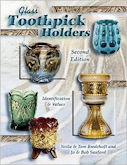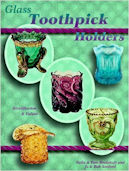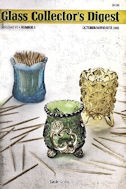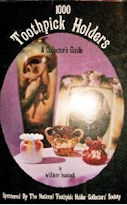Glass Toothpick
Holders from the
Glass Encyclopedia

Toothpick holder in
carnival glass
Nautilus pattern
If you are looking for
Toothpick holders there
are always some for sale
on eBay. See what there
is just now - click
Toothpick holders (glass)
Glass Toothpick Holders became popular in the 19th century with the introduction of disposable wooden and quill toothpicks. Before that time toothpicks were a personal item often made of gold, silver, or ivory and kept in a similarly expensive pocket case.
The typical Victorian table set included a toothpick holder alongside the salt, pepper and condiments containers. They were usually made from pottery, glass, or metal, and often in matching sets.
Glass toothpick holders were made by nearly all the great 19th century glass makers in the USA and in Europe. When matching sets of glass tableware became popular, the toothpick holder was an essential part of the set. Their heyday was from about 1895 to 1905, after which post-Victorian etiquette frowned on using toothpicks at the dining table, so they became less popular. Also about that time, cheap imports from Europe caused many US glass producers to cut out some items from their lines.
Toothpick holders became popular again as collectors items and were re-introduced later in the 20th century by companies focussing on collectible glass. Some were reproduced, like the little Nautilus one in blue carnival glass shown on the left. They are still made and still very popular today.
They make excellent collectibles because they are small and easy to display, not as expensive as some other glass items, and come in a very wide variety of colors and types of glass. Many toothpick holders sell for less than US$20 and there are always plenty available to buy at glass fairs and auctions or from glass dealers. Some of the most valuable glass toothpick holders are art glass made in Europe.
A question that is often asked is how do you tell a toothpick holder from a match-holder, a spill holder, an egg cup or a small vase? In some cases there is no difference - because the same item was sold by the original makers as both a toothpick holder and as a match-holder or even an eggcup (see Butler Bros. advertisements from the turn of the 19th century). And in come cases, such as those from Sowerby's (England) which are listed in all the main books about toothpick holders, they were not originally sold as toothpick holders, but rather as "spill vases".
The best test is a practical one suggested by the late William Heacock. Put some toothpicks in it. If they don't stand upright, but fall all over the place, then it isn't a toothpick holder!
It could be an egg cup or a salt container. If the toothpicks sink down so that their tops don't stand above the rim, then it isn't a toothpick holder. It could be a spooner, a cigarette holder, a spill holder or a small bud vase (a spill is an English term for a thin sliver of wood or a taper, intended for getting a light from a fire).
There is a popular collectors' club, the National Toothpick Holder Collectors' Society, who can be contacted at PO Box 852, Archer City, TX 76351, USA.








